Who Is Cole Palmer?
With the Premier League implementing the five-subs rule in 2022/23, we are set to see an increase in minutes for fringe players and academy graduates looking to cement their place in senior squads.
Due to the 2022 World Cup in Qatar, this will be an unprecedented season for football, particularly in Europe, and will likely assist in the breakthrough of these rotation players.
One such player who may look to take advantage of this is Manchester City’s 20-year-old talent Cole Palmer.
Despite a foot injury preventing him from impacting the second half of the season, 2021/22 could, overall, be seen as somewhat of a success for the local lad.
Scoring his first Champions League, FA Cup and Carabao Cup goals supported Palmer’s impressive performances at senior level, alongside scoring eight goals in eight PL2 games.
His displays pre-injury also saw him secure a starting role with England under-21s, a squad with strong competition for places, to qualify for the 2023 under-21 Euros.
He will be highly influential for the Young Lions next summer, but this could come after a potential breakthrough season for Palmer at the club he joined at the age of eight.
Despite being such a
strong advocate for five subs, Pep Guardiola has made the fewest substitutions in the Premier League by a significant margin in the last two seasons.
Palmer’s positional competition in the City squad averaged 21 Premier League starts last season (“Pep Roulette”).
The youngster’s versatility will help him become an active option in Guardiola’s small squad in 2022/23, as the boss will surely look to increase his number of substitutions in the intense and congested calendar.
Palmer is a left-footed attacker who prefers to operate on the right side of the pitch.
His profile naturally resembles that of teammate Riyad Mahrez.
Guardiola has trusted Palmer on the right-wing, in midfield and spearheading the forward line.
For Lee Carsley’s England under-21s, he has been best utilised on the right wing.
This tactical analysis and Cole Palmer scout report will examine his suitability for playing as the right-winger, right-sided central midfielder, and centre-forward in Pep Guardiola’s system.
Cole Palmer Position As Right winger
Standing over six feet tall, Cole Palmer does not have the typical stature of a Pep Guardiola winger.
Pedro, David Villa, Arjen Robben, Franck Ribéry, and Raheem Sterling have all been successful with Guardiola but are short in comparison to Palmer.
However, the players do share similarities regarding elegant dribbling, ball retention in tight areas and the trio of speed, agility and quickness (SAQ).
Despite Palmer’s figure, he is graceful in possession, gliding infield off the right wing predominantly with his left foot.
With the use of various feints and good ball manipulation, he can comfortably maintain possession or face up a defender to take them on and evade them with his agility and acceleration.
Whilst Guardiola usually lines City up in their conventional 4-3-3 shape, their shape in possession shifts to more of a 2-3-5.
The full-backs tend to narrow and occupy spaces near pivot player Rodri ahead of the two centre-backs.
In the front five, the wingers generally act as width holders, providing maximum width to horizontally stretch the opposition’s defence.
As a result, deploying Palmer on the right wing will make him the right-sided width holder.
This is a role that Palmer is familiar with after his experience with the England under-21s.
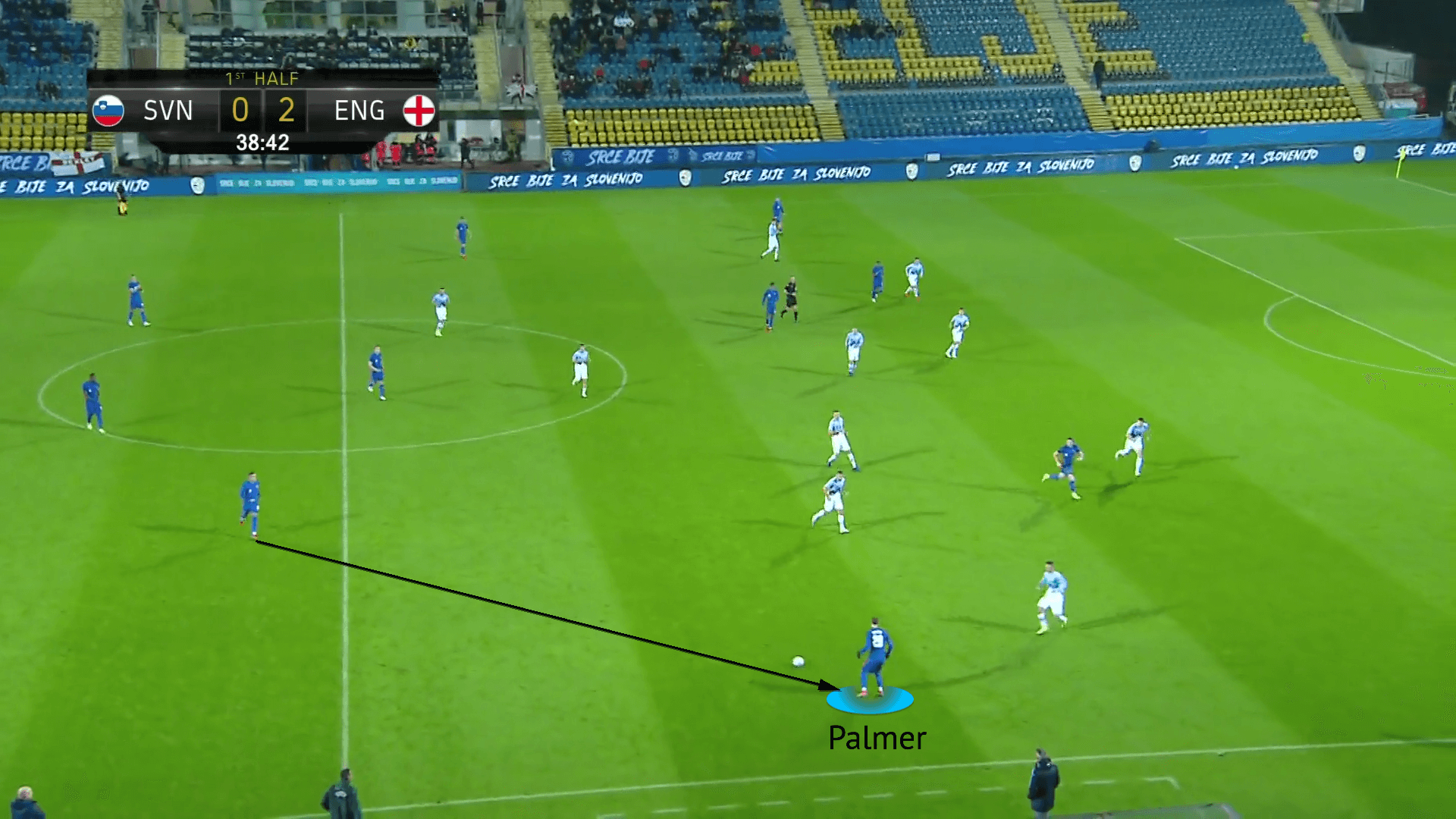
The figure above displays Palmer’s role as a width holder with Carsley’s Young Lions in a similar 2-3-5 shape.
After dropping away from the defensive line to create a safer passing lane, Palmer receives a pass in the widest channel from right-back Max Aarons.
Using the studs on his right foot to stop the ball dead, he engages the Slovenian left-back and takes a touch inside.
This touch inside makes the left-back commit, and Palmer reacts with a smooth Cruyff turn and a mix of close control and balance to evade the pressure, as we can see in the image below.
This has given him space to get his head up and pick a pass unpressured.
Central midfielder Conor Gallagher’s run into the wide area has opened the passing lane in the left side of the Slovenian defence for striker Rhian Brewster to make a run across the face of the defender to receive the pass in behind.
Palmer’s pass was weighted perfectly in Brewster’s stride, with the former Liverpool striker forcing a good save from the goalkeeper.
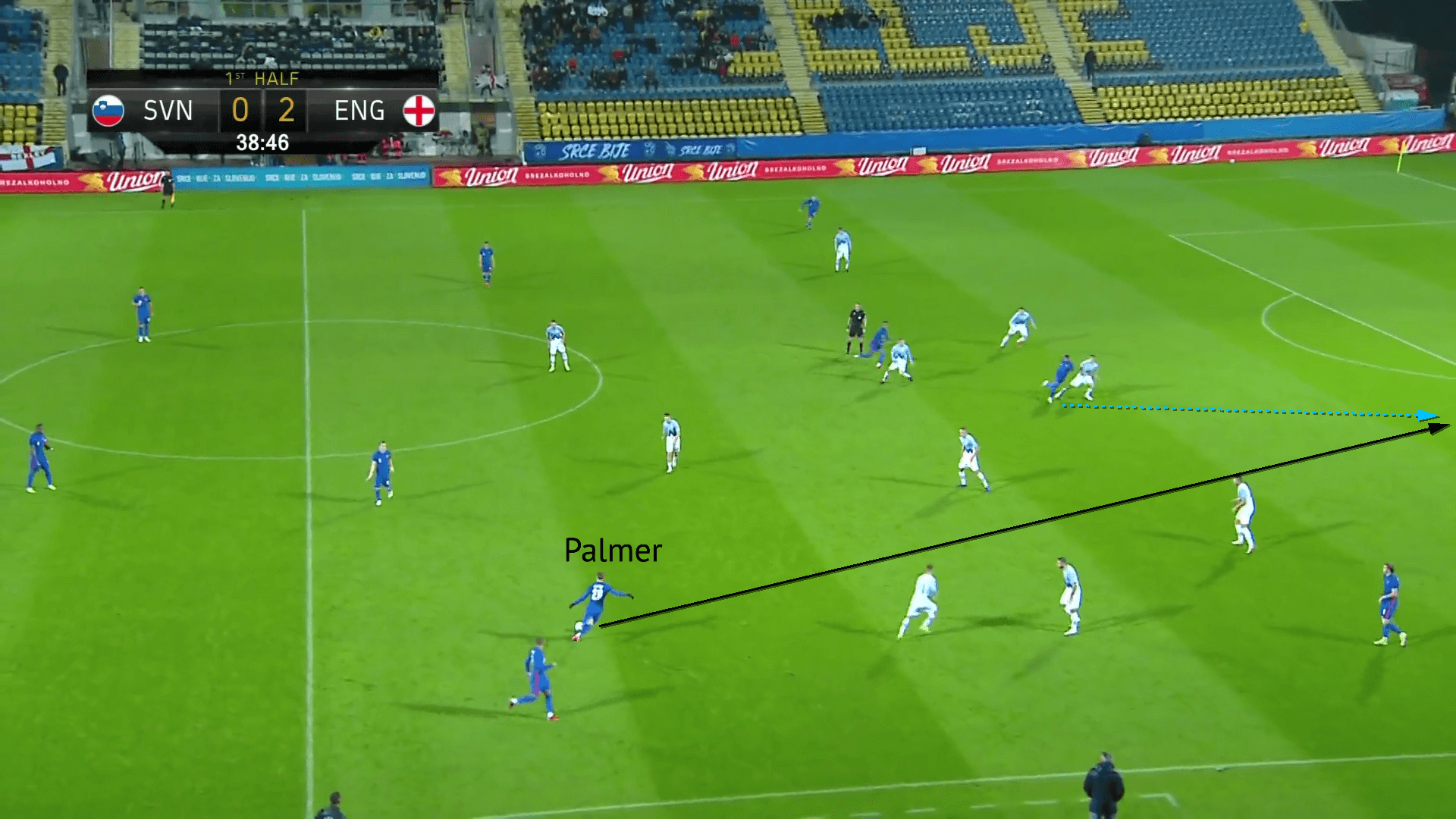
The right-winger’s responsibility to provide the width will not be a constant in every Manchester City passing sequence next season.
With their fluid positional play and a general rule of no more than two players on the same vertical line, the players must react to teammates’ movements and constantly rotate to create passing options and disrupt opposition defences.
Palmer shows a clear understanding as a right-winger of when to invert and open space in the widest channel.
This is crucial for City and the variety they possess when attacking in wide areas.
With the lightning pace of Kyle Walker and Kevin De Bruyne’s tendency to drift into the right channel and provide devastating whipped crosses, the winger must be capable of driving inside and taking up a more central position.
As a left-footed right-winger with lots of familiarity in central areas, this is a natural movement for Palmer.
He can cut inside and drive at the defence from the wing to create space out wide, while also having the technical proficiency to receive and operate in tight areas centrally.
An example of this is shown below against Club Brugge.
In a fluid attacking five of Palmer, Mahrez, Grealish, Sterling, and Ílkay Gündoğan, the Young Lion receives a short pass from Rúben Dias in the right half-space as right-back Walker has become the right-width holder.
He takes a heavy first touch away from danger towards Walker before turning back inside.
With a square body shape facing inside, indicating a pass centrally, Palmer quickly rolls the ball back and rotates his body, allowing him to utilise Walker’s overlapping run.
Walker’s speed, alongside the fluent movement and execution of Palmer’s skill and pass, is indefensible for Club Brugge.
Palmer’s pass is once again exceptionally weighted to meet Walker’s run.
This attack should have ended in a goal.
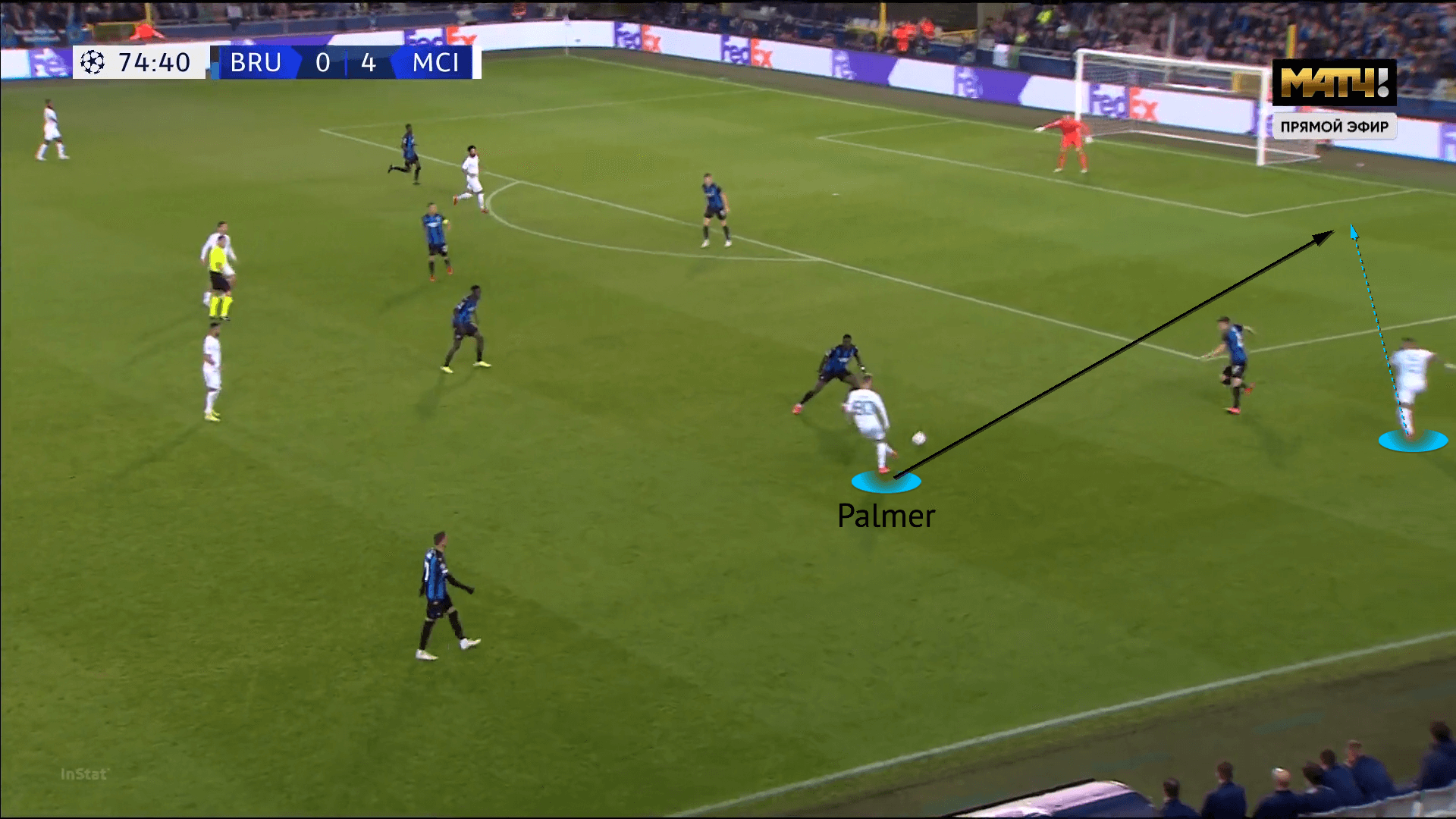
Palmer has a knack for executing well-timed passes that penetrate opposition defences, creating a lethal combination when paired with his weight of pass.
He has shown semblances of ‘La Pausa’, momentarily slowing down in possession to draw opposition and find the opportune moment to release the killer pass, which will continue to develop under the tutelage of Guardiola and his staff.
When coming inside with the ball, Palmer likes to engage the nearest opponent and ball-side centre-back to play a slip pass down the side of the defender for a blindside run from the striker or advancing midfielder.
He can also play this type of pass between the opposition left centre-back and left-back when operating as the width holder.
When he is in the final third with an overlap arriving, he tends to integrate the elements of ‘La Pausa’ with his preferred skill of a Cruyff turn/fake shot.
We’ve seen Palmer display this combination in the above figure against Club Brugge, but he has also accessed the overlapping runs of Walker and De Bruyne against Swindon Town, in particular.
Despite the self-explanatory responsibility of the width holder to maintain maximum width, they must also have the decision-making of when to effectively ghost inside from the wing to penetrate the defensive line.
As a left-footer with a clinical eye for goal, this could be incredibly prolific for Palmer in the final third, with teammates such as João Cancelo and Rodri capable of clipping lofted passes behind defences with incredible accuracy.
The young talent has also displayed the ruthless goalscoring nature of arriving in and around the box to attack crosses from the left-wing, with this movement resulting in his goal against Slovenia under-21s.
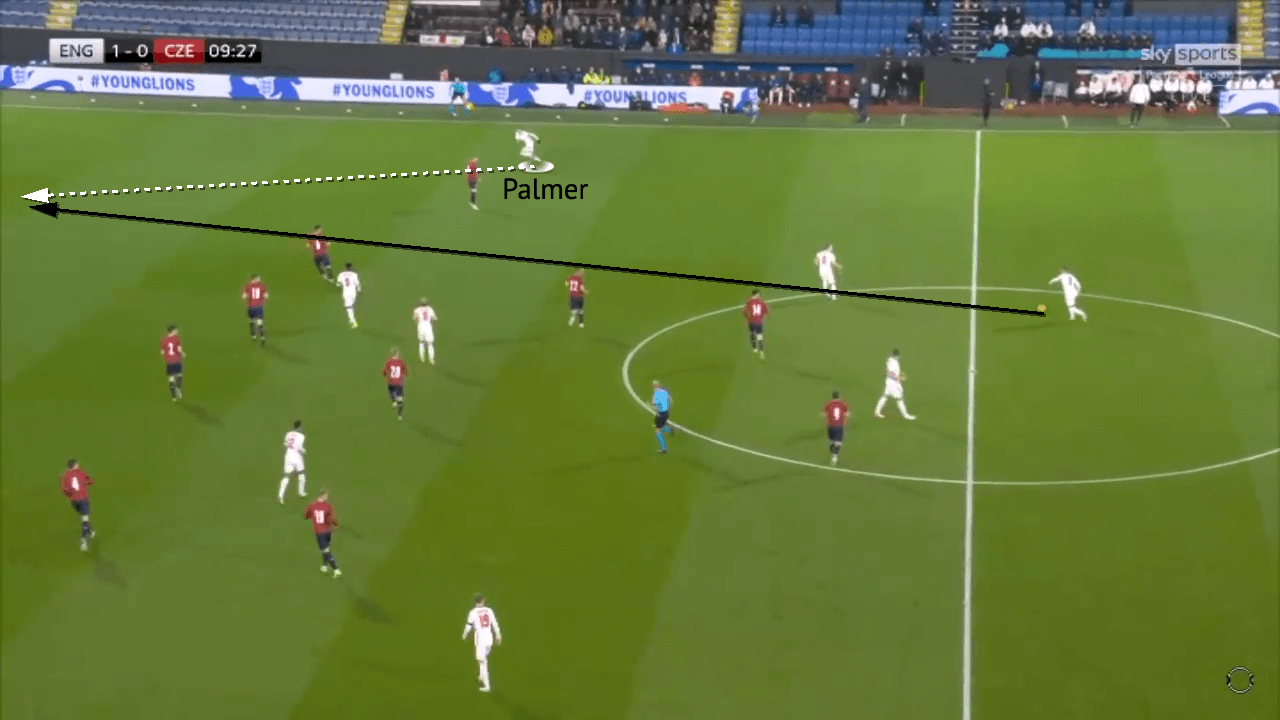
From deeper stages of possession, Manchester City can be seen employing these runs to offer a more direct route of penetration, particularly against an opponent’s five at the back.
We can see this situation in the figure above, once again involving Max Aarons and England under-21s.
Starting on the touchline, Palmer makes a blindside run on the static Czech Republic defender triggered by Aarons taking a touch out of his feet with his head up to spot Palmer’s run.
The winger enters the box and wins a corner after executing his trademark fake shot.
Palmer’s trigger for making these ghosting runs off the wing is eye contact with the ball carrier to show a shared understanding.
With their quality passing range, right-backs Aarons and Walker or the likes of Rodri, John Stones, and Kalvin Phillips could execute these passes from deep.
However, he doesn’t quite have the rapid sprints over longer distances like Phil Foden and former City wingers Raheem Sterling and Leroy Sané that could optimise the threat of these penetrative passes in behind defences.
Improvement on this physical attribute tends to only increase speed by a fine margin but Foden’s work with sprint coach Tony Clarke has seen noticeable improvements in the fellow academy graduate’s speed.
Although he might not have an electric pace, Palmer does possess superb nimbleness.
This is a clear strong point of all his physical attributes and is crucial to his play in the final third.
The technically gifted attacker has a plethora of ball manipulation techniques to unleash in the final third and bamboozle defenders.
His excellent agility and balance provide the foundations for Palmer’s variation of footwork when on the ball.
Although capable of more complex skills, Palmer executes body feints and fake shots with such effectiveness that they have become his primary actions for deceiving and beating opponents.
Drag-backs, ball rolls, and stepovers are also among his mastered techniques, but his agility and acceleration underpin his accomplished dribbling.
Palmer’s ball manipulation often gives him qualitative superiority in 1vs1 and next season, we will see him humiliate some of the Premier League’s most established defenders.
This qualitative superiority regularly sees the opposition double down on Palmer, but the City starlet still manages to come out on top.
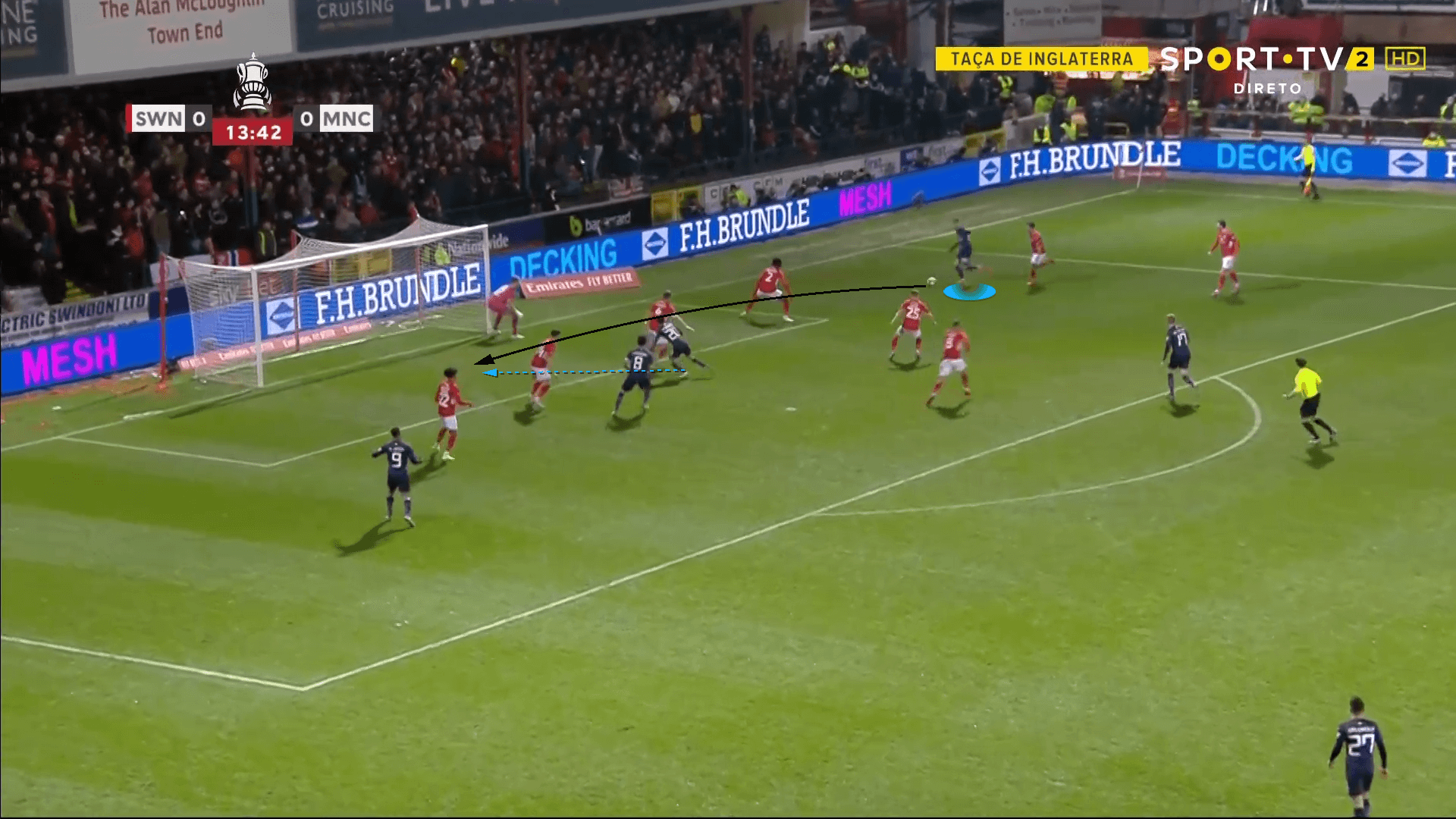
The image above is an example of this against Swindon which results in Palmer assisting a tap-in for Bernardo Silva.
Palmer received an overhit Walker pass wide on the right, immediately attracting Swindon’s left wing-back and left central midfielder in their 5-3-2 formation.
Predominantly using his left foot, the winger dribbles infield with a stepover before shifting the ball to shape up for a cross in between the two players.
With the wing-back committing to block the cross, Palmer executes his trademark fake shot to chop the ball past the defender on the outside.
Utilising his burst of acceleration and quick feet, he wriggled away from the defender and drilled a right-footed pass across the face of the goal, using the Swindon left centre-back to shape his cross into Bernardo Silva’s path.
His ability to attract and draw in multiple opponents would be beneficial for any team but is particularly productive for a side of Manchester City’s quality.
He seldom uses his right foot but he has displayed clean ball-striking, such as the above cross at Swindon, that could potentially add another dimension to his game in the final third.
Meanwhile, his ball striking on his left foot is one of his most notable strengths.
Despite being 20 years old, Palmer has accomplished the left-footed shot to the far post when coming off the right wing.
Striking the ball with the inside of his foot, his shot has the ideal pace and bends with clinical accuracy to beat goalkeepers at the highest level.
With flair in abundance and confidence in his shooting, Palmer is not afraid to attempt speculative shots from tight angles and distance.
He can also unleash powerful strikes at the near post or delicate chips over the goalkeeper, showing variety in his shooting, dribbling, and passing techniques.
The image below shows his goal against Swindon. With pin-point accuracy from his left foot, he found the top corner with an unsavable shot.
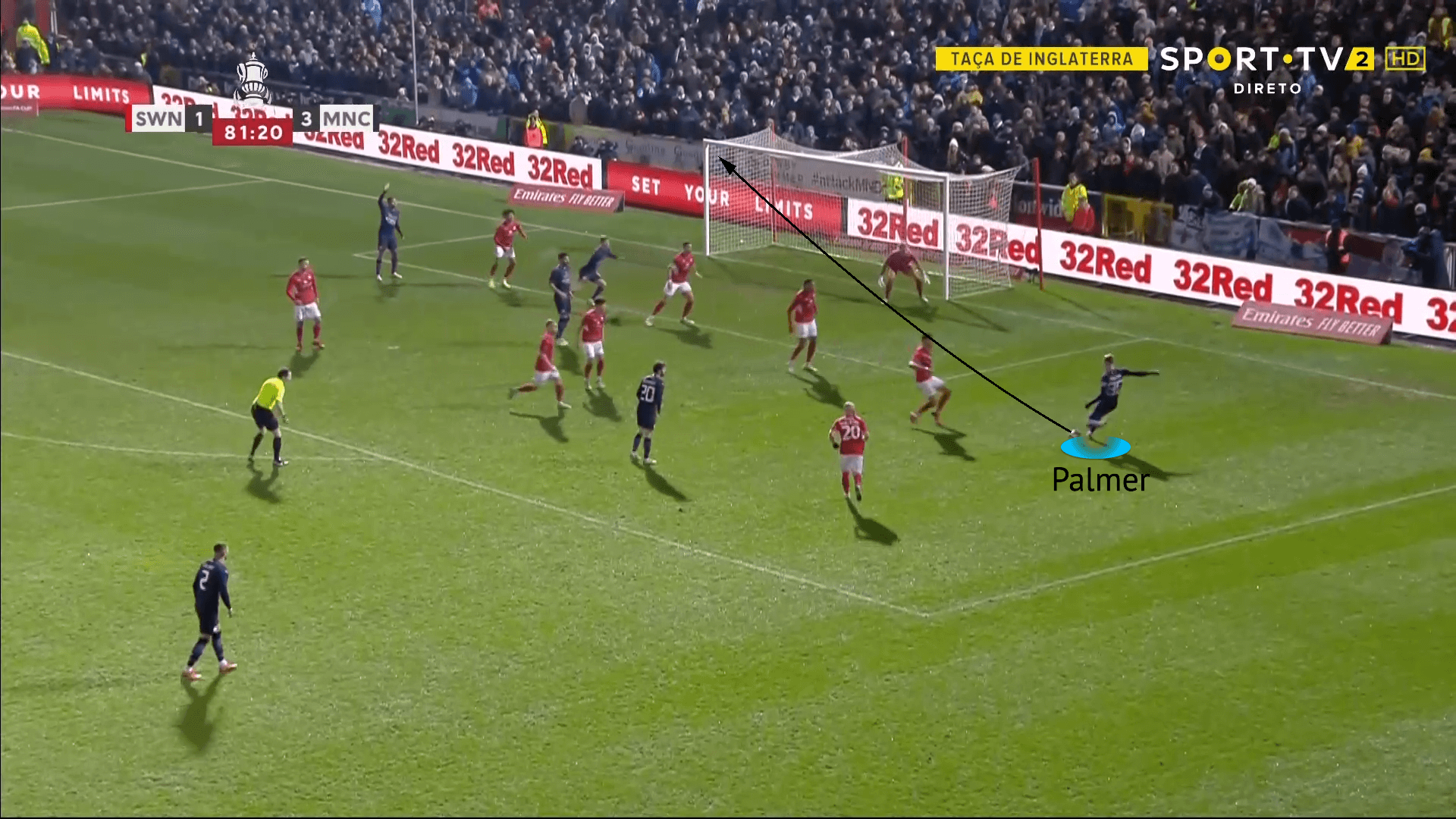
Right of the midfield three
Last season saw Manchester City most commonly set up in a 2-3-5 shape in possession.
However, towards the end of the season, there were occasions when Guardiola would shift into more of a 4-2-4.
This happened most commonly in the build-up, but it could also be seen in more advanced phases.
Especially when playing against high-pressing teams, goalkeeper Ederson and City’s centre-backs would often invite pressure with the full-backs and double pivot helping to stretch the opposition horizontally.
With the 4-2 base deep in the build-up phase, City could attract and bait lines of opposition pressure to enlarge the space between the midfield and defensive lines.
With two of the midfield three in City’s on paper 4-3-3 deep in the double-pivot, the remaining central midfielder would advance to the enlarged space between the lines.
From here, the midfielder would be an option to escape pressure and help progress out of the build-up phase whilst giving an opposition midfielder/defender the choice of either leaving their shape or allowing the City midfielder to be free.
Arguably, the effective combinations for this
tactic in Manchester City’s world-class midfield department were a trio of Rodri, Bernardo Silva,and Kevin De Bruyne.
Left-sided central midfielder Bernardo Silva would drop alongside Rodri, while right-sided central midfielder De Bruyne would advance behind the opposition’s midfield line.
Allowing Bernardo Silva to drop maximises the Portuguese midfield maestro’s ability to contribute to all phases, including build-up, with his supreme ball retention and progression and unrivalled endurance.
De Bruyne, on the other hand, effectively acts as a second striker.
By operating further up the pitch, City are also optimising the Belgian’s world-leading combination of lethal ball-striking off both feet and elite chance creation in the final third.
Since the start of 2022, De Bruyne has scored 13 goals and assisted 12 more in just 24 games for City.
This role certainly gets the best out of De Bruyne and would be the midfield role best suited to Cole Palmer.
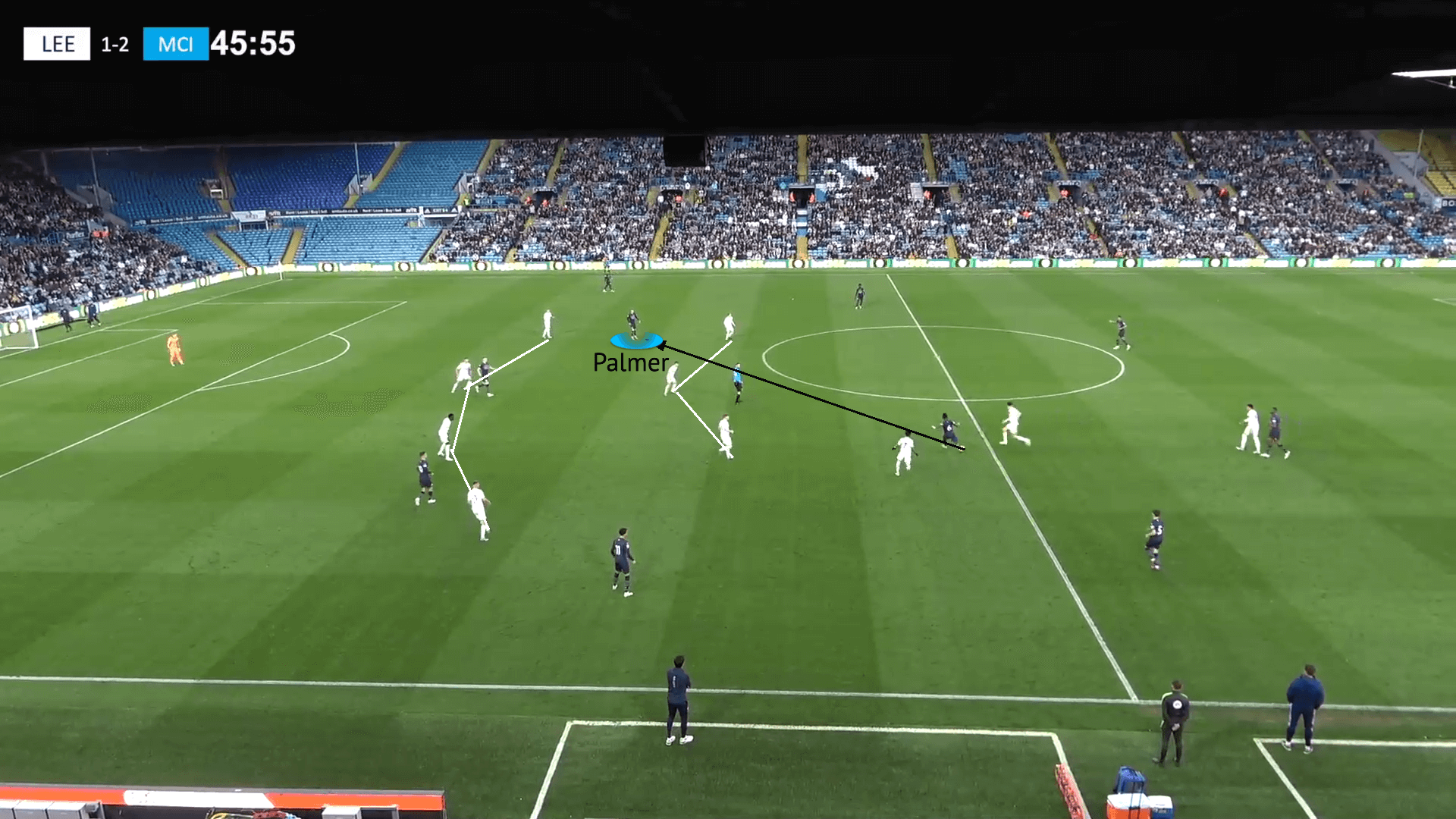
The figure above shows Palmer occupying these positions between the lines as the right-sided central midfielder.
The image clearly defines the Leeds United under-23s defensive and midfield lines, with Palmer positioned between them.
The Young Lion receives a line-breaking pass from Roméo Lavia on his right foot and holds off pressure from the Leeds left-back.
Driving towards the box, he skewed his shot wide, aiming for the bottom right corner.
When deployed as a central midfielder, Palmer has shown effective off-the-ball movements reminiscent of some of his more senior teammates.
In this very game against Leeds, Palmer combined well with right winger Kayky to provide an underlapping run and receive the Brazilian’s through ball before slotting the ball past the goalkeeper across the goal.
This type of role for the right-sided central midfielder will likely remain for Manchester City during the 2022/23 season, regardless of whether their in-possession shape is more of a 4-2-4 or a 2-3-5.
With their left-back arrival likely to be better suited to the role of left-width holder rather than an inverted full-back, the left-sided central midfielder will probably sit deeper.
This would effectively have them positioned alongside Rodri and the right-back in the 2-3 base.
Additionally, the signing of star striker Erling Haaland will also influence the right-sided central midfielder’s role of acting like a second striker, as City and Haaland will have to adapt to each other.
The positioning and technical quality of the right-sided central midfielder will help alleviate any deficiencies in Haaland’s play in congested areas.
Although Palmer can occasionally take a poor touch, he largely has the technical qualities to perform this role.
He is intelligent with his first touches, scanning over his shoulders and taking the ball away from the direction of the nearest opponent.
This is crucial when receiving in such tight central areas.
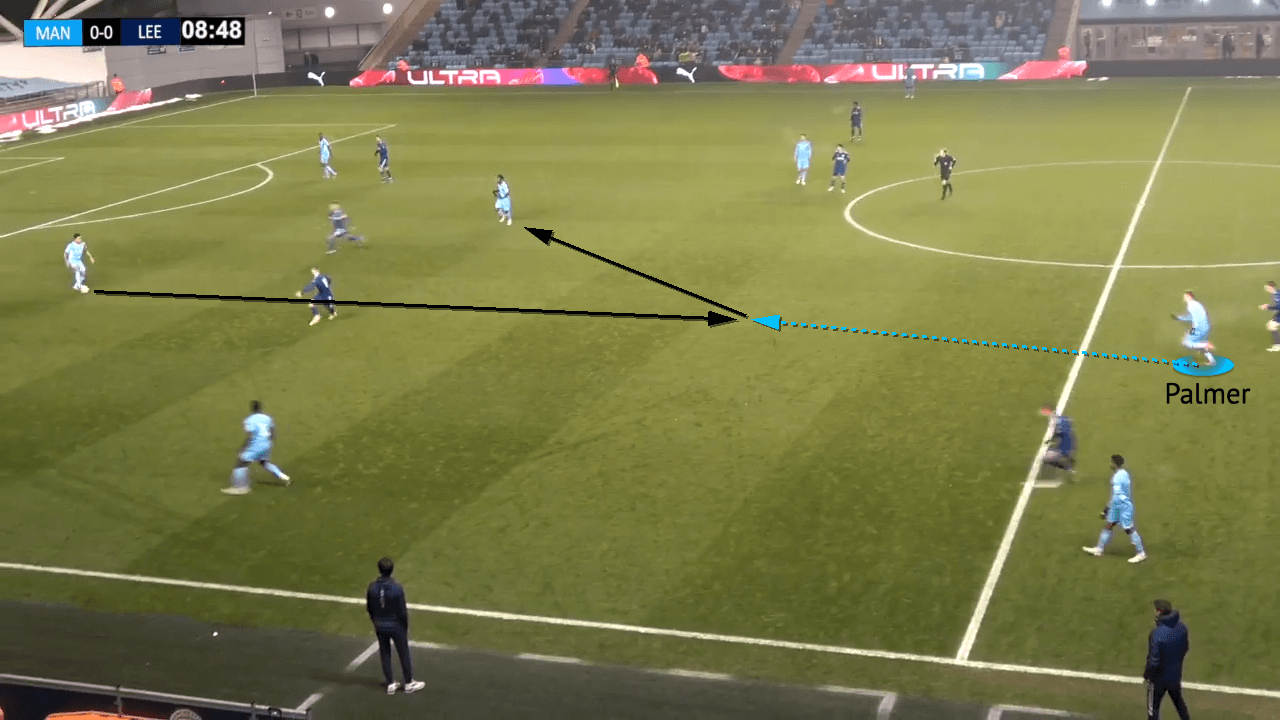
Despite City’s recent setup usually involving very little of the right-sided central midfielder deeper in the build-up phase, there are times when they drop back if needed.
Palmer has displayed this ability to acknowledge when help is needed in the build-up phase and drop back to retain and progress possession.
In the image here, Leeds have intensely applied pressure to the City defenders and pivot player, limiting their touches on the ball.
City has managed to recycle possession in the backline and create a potential opening for right-back Kwaku Oduroh, but Palmer has dropped back from alongside the striker to provide a central option.
Centre-back Egan Riley decides to play into Palmer’s feet, who calmly lays the ball off first-time to Lavia.
Lavia completes the up-back-through combination by finding the striker, who plays a return pass to Palmer after he made a forward run.
Carrying the ball towards the penalty box, Palmer’s shot was deflected out for a corner.
Similar to his confidence with shooting, he is comfortable and brave receiving with his back to goal.
The main aim when receiving as a central midfielder for City is to receive on the half-turn and open play ahead of the ball.
However, when tightly marked, this is not a viable option.
Palmer’s tendencies to use feints to confuse and break free of his marker are used when receiving with his back to the goal, as well as when facing forward.
This tends to result in Palmer taking multiple touches and travelling towards his own goal.
This is a risky approach wherever on the pitch, but particularly so as a central midfielder.
There are positive elements to these carried by Palmer.
If tracked by an opponent, he has created a gap in the midfield, which could then be infiltrated by a teammate to receive a pass or Palmer himself. If the opposition marker does not continue to follow Palmer, he is free to turn.
With the high stakes and elite level of the Premier League and UEFA Champions League, Palmer’s habit will need to be ironed out for him to operate as a central midfielder to his full potential.
However, Manchester City has a large number of technically assured players, so he will always have teammates willing to receive a pass when facing his own goal.
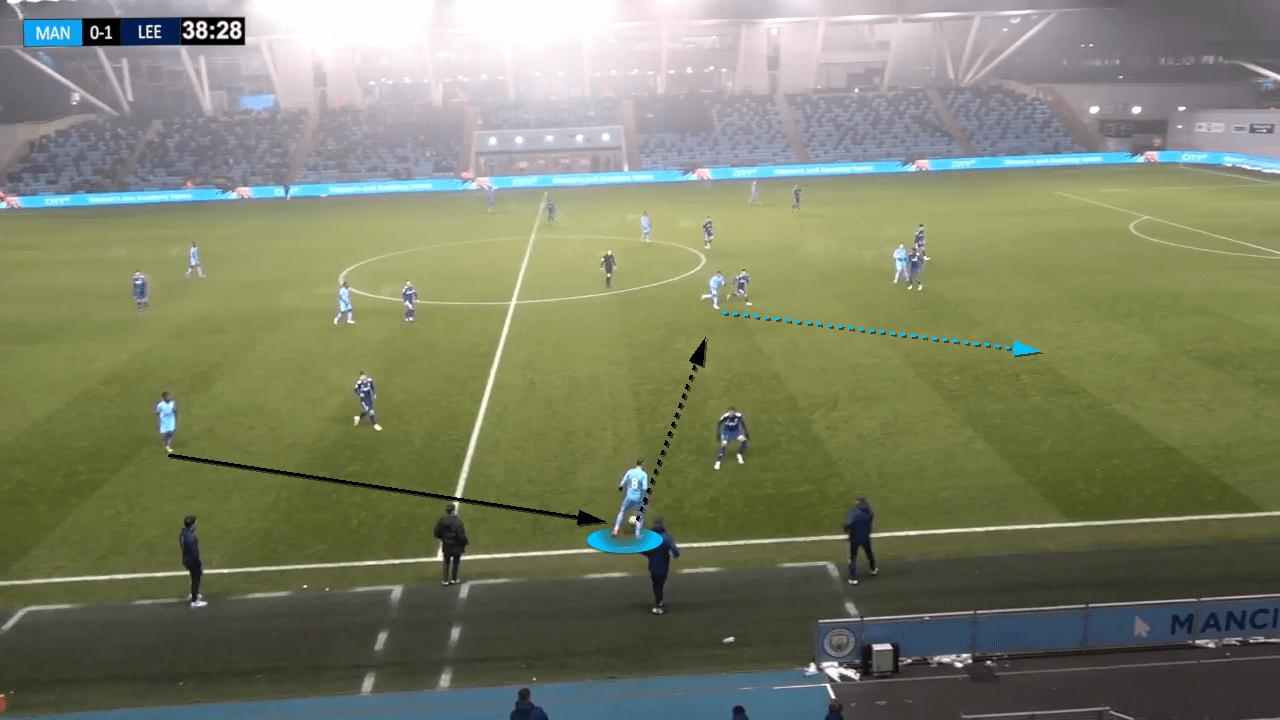
Earlier, we discussed Palmer’s understanding of positional play under Guardiola as a right winger trying to occupy a different vertical line from the right back.
With the fluid rotations that result from City’s positional play, the central midfielders can be seen drifting into wide areas.
This is natural for Palmer due to his familiarity with operating in the widest channel.
This separates him from most central midfielders, who are generally fazed by the touchline constraint and in-to-out pressure from the opposition.
The image above shows Palmer drifting to the touchline because Kayky is occupying central spaces.
Receiving off right-back Oduroh, Palmer patiently brings the ball forward at a slow pace.
This slower speed has given Kayky time to move wide ahead of the ball and created space for Palmer to burst into.
Powering between two Leeds players, he glides infield towards the penalty box and passes to James McAtee, another exceptionally talented youngster with first-team potential at City, who creates a shooting opportunity.
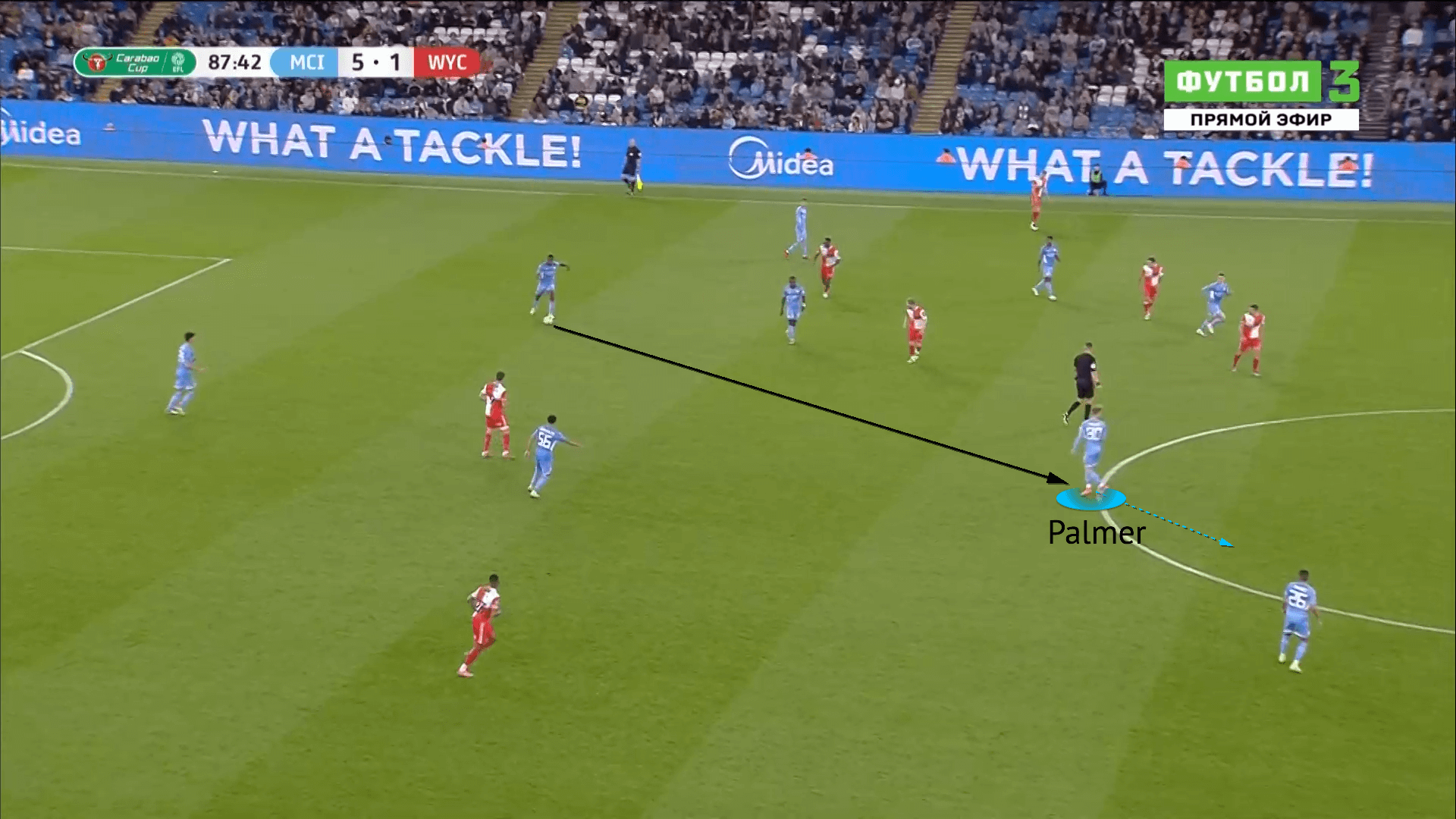
Out of possession, Palmer does not engage in many defensive duels.
He will be an avid presser in the front two or more disciplined on the wing of City’s common 4-4-2 out-of-possession shape, but he would not be relied upon in the double pivot.
As his playing time in the first team increases, Palmer will naturally improve his defensive decision-making and recognition of pressing traps and triggers and the subsequent movements required from his role as a right winger, right-sided central midfielder or centre-forward.
Although this may not be up to scratch right now, he can be forgiven due to the value he provides in transition.
In attacking transition, Palmer is incredibly forward-thinking with both his on and off-the-ball actions.
The image above shows an effective transition with Palmer against Wycombe Wanderers.
As Lavia regains possession and finds left-sided centre-back Luke Mbete, Palmer repeatedly scans over his shoulder and drifts into space between the lines.
He receives on the half-turn perfectly and breaks forward, as shown below, with City having a 4vs3 attacking overload.
With world-class attackers and ball-strikers De Bruyne, Foden and Mahrez alongside him, Palmer displays his confidence by going alone.
Carrying the ball to the edge of the box, the academy graduate whips a left-footed shot past the goalkeeper to score his first senior goal for Manchester City.
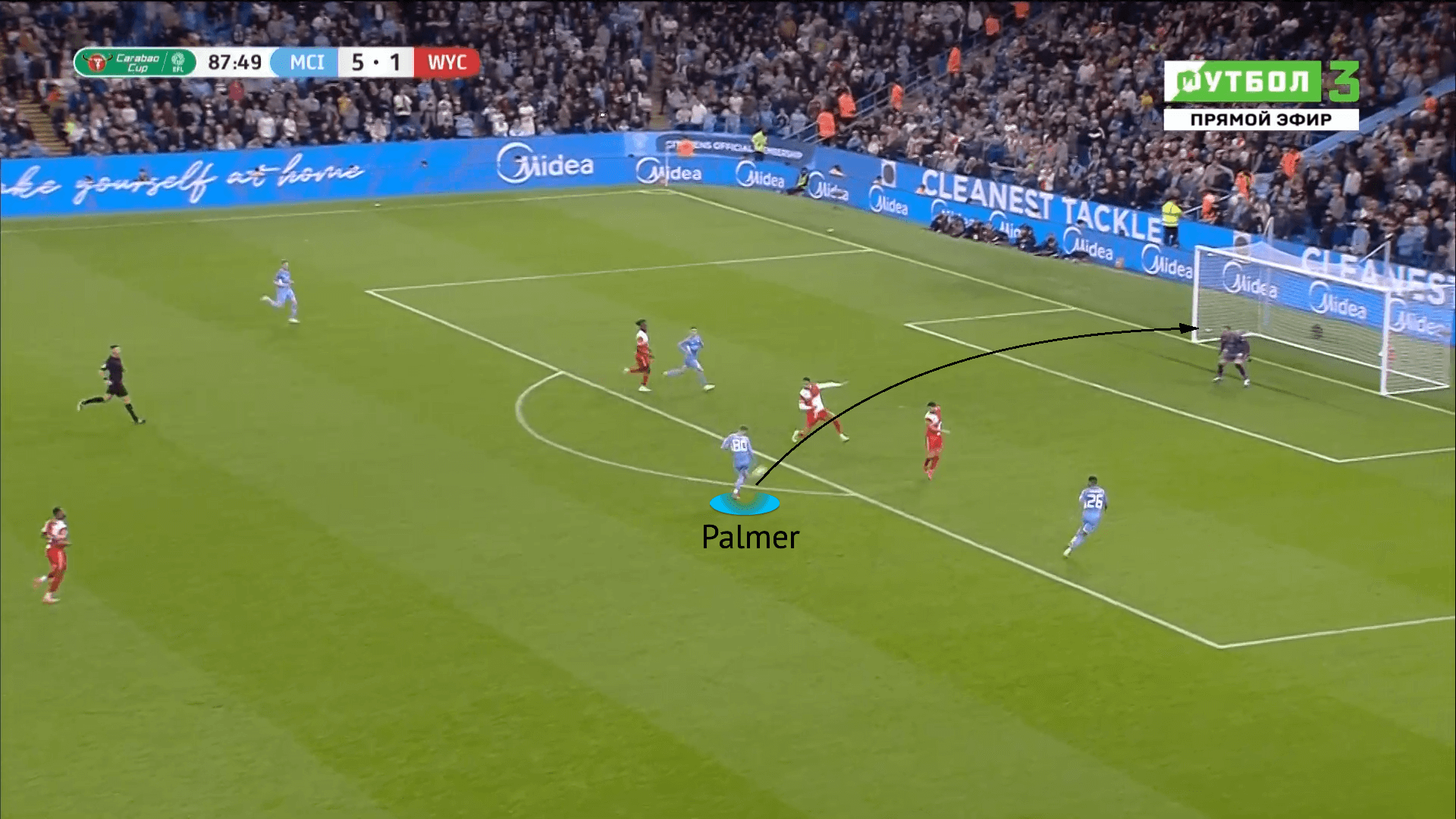
By operating in deeper central areas, Palmer can break into the box and arrive at goalscoring positions.
Earlier, we mentioned his movement off the right-winger to arrive in the box, but Palmer also does this centrally with his transition threat.
His goal against Club Brugge came from a transition, arriving on the edge of the box to receive Raheem Sterling’s pass and scoring with his first touches off the bench.
Palmer bonded well with Sterling, citing him as a player who has provided guidance to him both on and off the pitch, like a Caribbean connection between Sterling of Jamaican heritage and Palmer of Saint Kitts and Nevis descent.
The image below shows the two looking to combine and get in behind the Club Brugge defence with a stereotypical move involving a false nine.
Jack Grealish receives the false nine and drops off, vacating the central space for Sterling to make the out-to-in run.
Releasing the ball to Palmer, the Young Lion attempts a tough half-volley through ball into the space for Sterling to attack.
The pass was slightly overhit and ran through to goalkeeper Simon Mignolet.
The technique required for the attempted pass would be difficult for any player, once again showing Palmer’s trust in his technical ability.
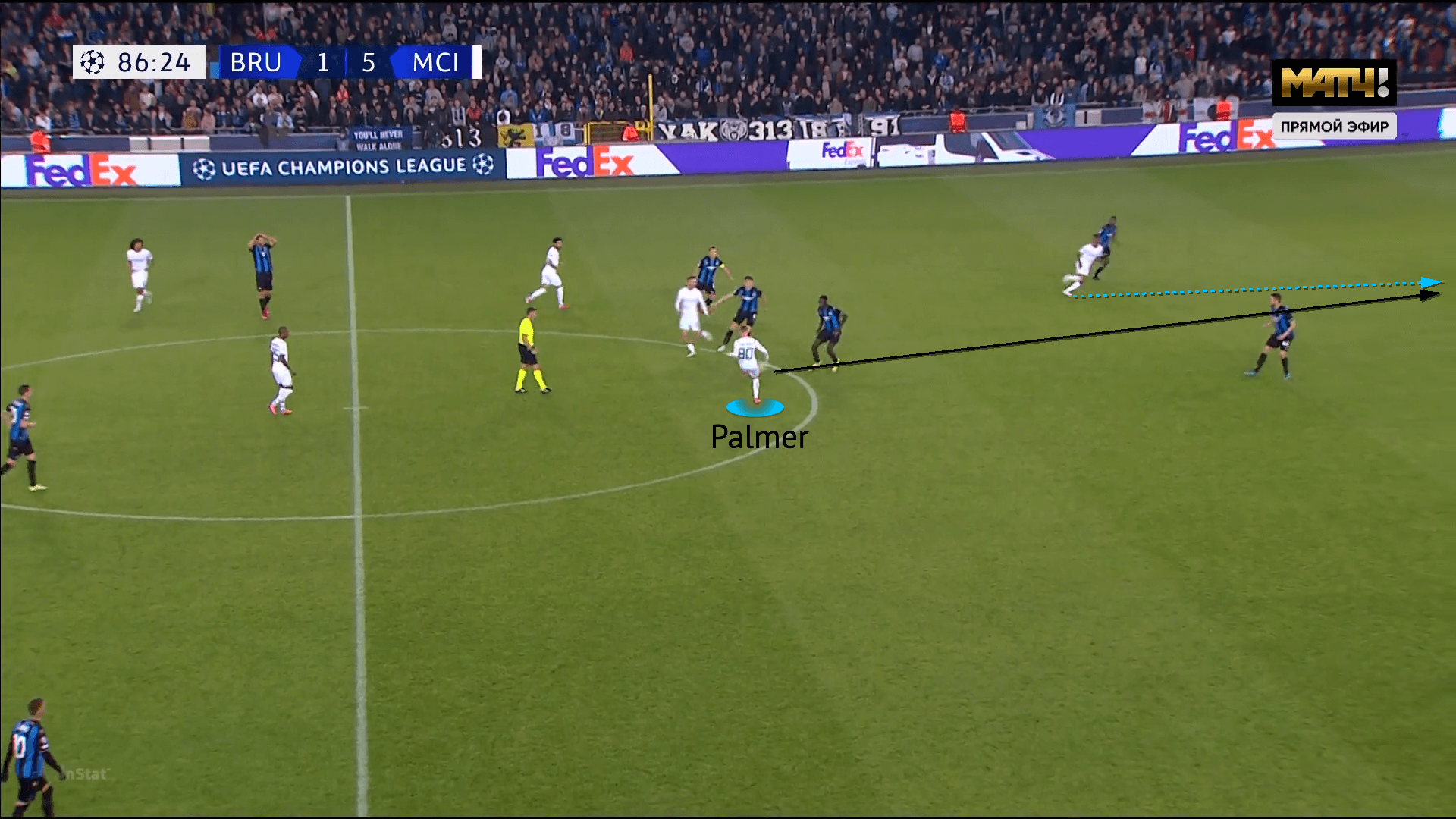
With his previously mentioned traits of good weight and timing of passes, self-confidence, and a variety of techniques, Palmer is a player who regularly attempts to play the final killer ball.
Some could deem his decision-making and passing the final third as hasty and forcing play, but, at the same time, risk is required to penetrate defences at the highest level.
He is capable of finding forward players to feet or with passes in behind.
Inside the box, he can use his ball manipulation to create passing angles in tight and congested spaces.
Below is an example of his intricate play in and around the box.
Receiving on the edge of the box, he drifts past a Czech Republic midfielder and holds on to the ball, attracting the attention of four Czech players.
As the defenders engage, he slips a pass through their legs to find Folarin Balogun’s movement behind the defence.
Nutmegging opposition is a regular occurrence for Palmer.
This is added to the collection of skills and techniques Palmer uses to deceive and embarrass opposition defenders.
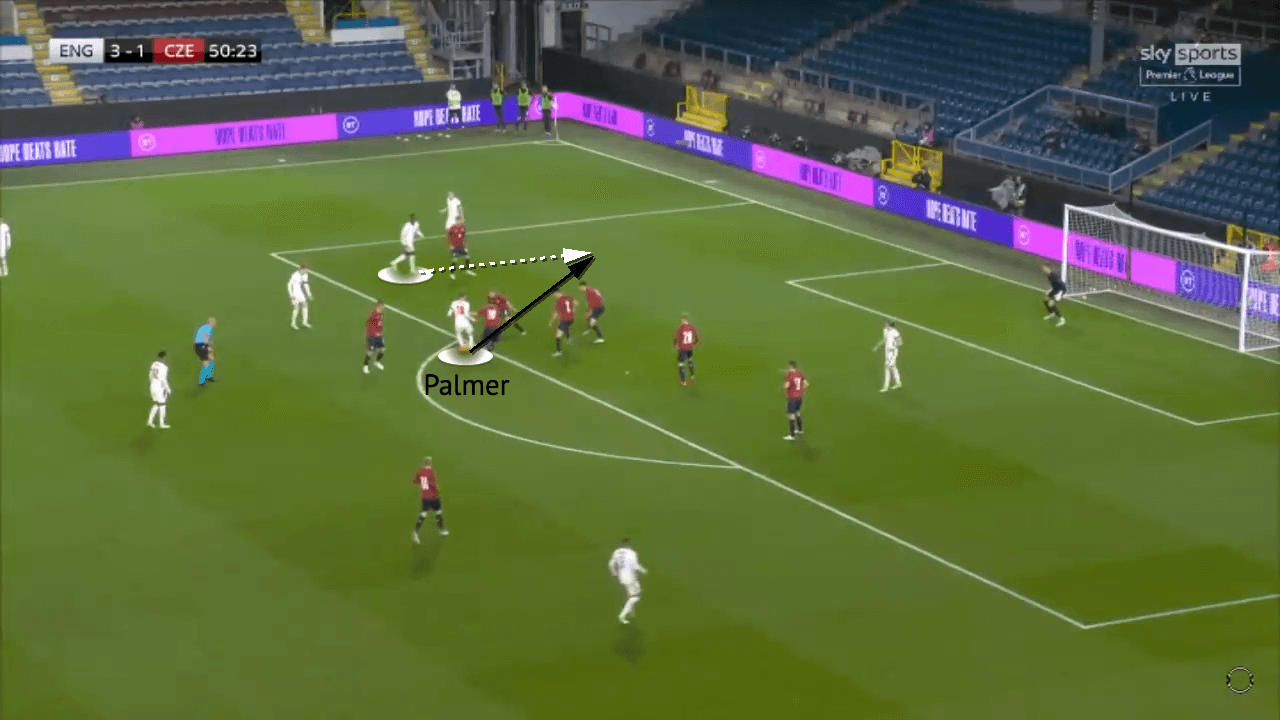
Centre-forward
With two elite striking talents arriving at Manchester City this summer in the form of Erling Haaland and Julián Álvarez, it is implausible that Cole Palmer’s bright future lies as a centre-forward.
However, during the 2021/22 season, Pep Guardiola trusted Palmer to play the centre-forward role in his appearances against higher-quality opposition.
The City youngster started in this role against Everton and West Ham and made substitute appearances against Newcastle United and Club Brugge.
Palmer offers a different profile with different habits when spearheading the attack in comparison to Haaland and Álvarez.
If Guardiola wants his centre-forward to drop deep into the midfield to create overloads, as Jack Grealish previously has, then Palmer would be a good fit.
The figure below shows Palmer dropping ahead of the West Ham double-pivot of Mark Noble and Tomáš Souček to receive off centre-back John Stones.
He manages to find enough space between the Souček-Noble-Lanzini triangle to receive on the half-turn.
Now facing forwards, Palmer drives between the double pivot, utilising his ball-carrying and acceleration to skip past the sliding challenge from Souček and break the midfield line.
He plays wide to Sterling and enters the box, receiving a pass back from Sterling but shooting over the crossbar.
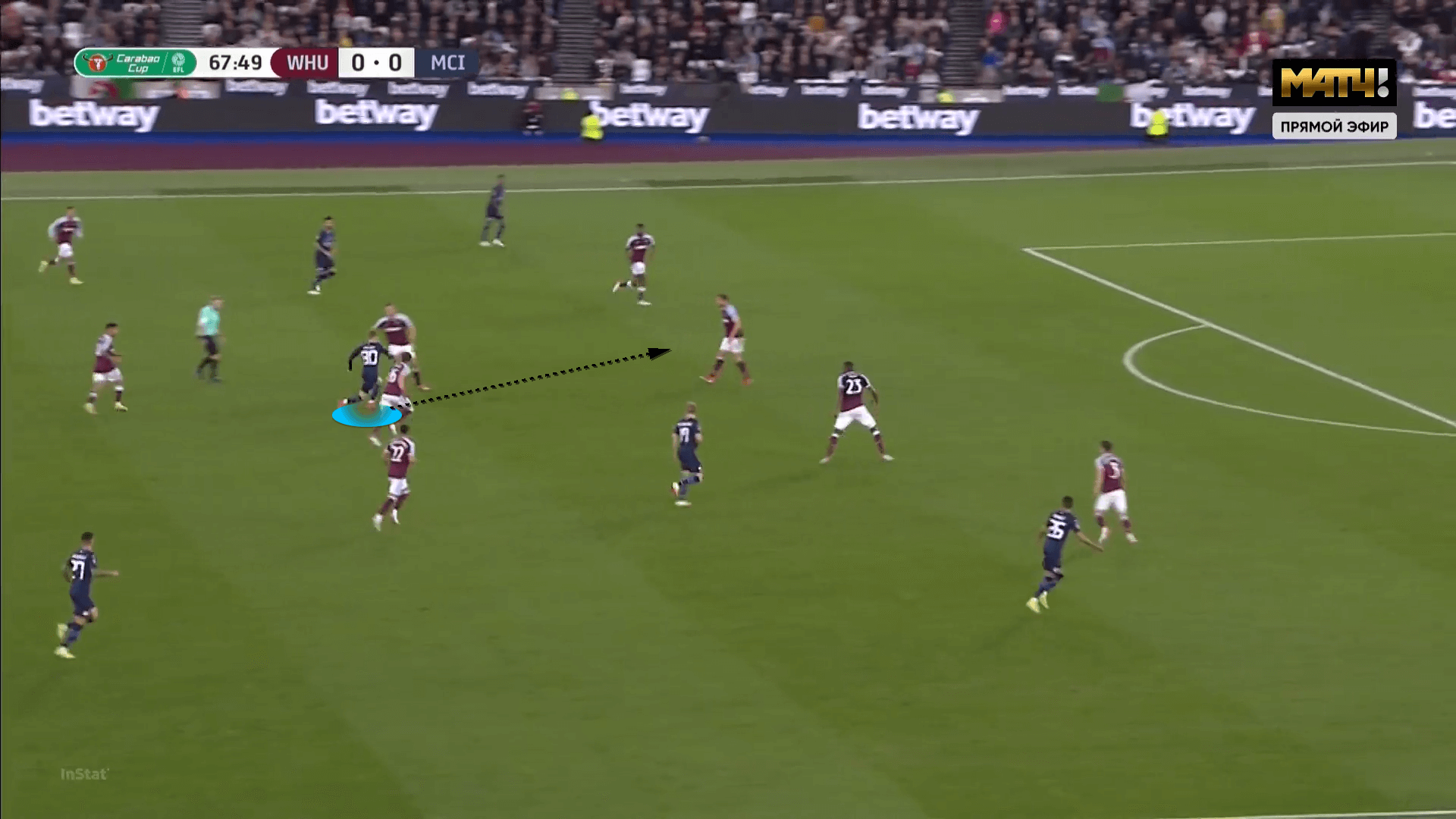
Palmer’s ball-carrying is a key component of his playing style and is something that sets him apart from Álvarez and Haaland.
Although Álvarez likes to operate between the lines with good link-up play, the Argentine doesn’t dribble at defences quite as Palmer does.
As stated earlier, his dribbling moulds his transition tendencies and helps him be so effective in these situations.
Despite the fewer forward passing options available for centre forwards, Palmer has displayed his passing in attacking transitions by dropping off to receive.
An example of this is below against Newcastle away.
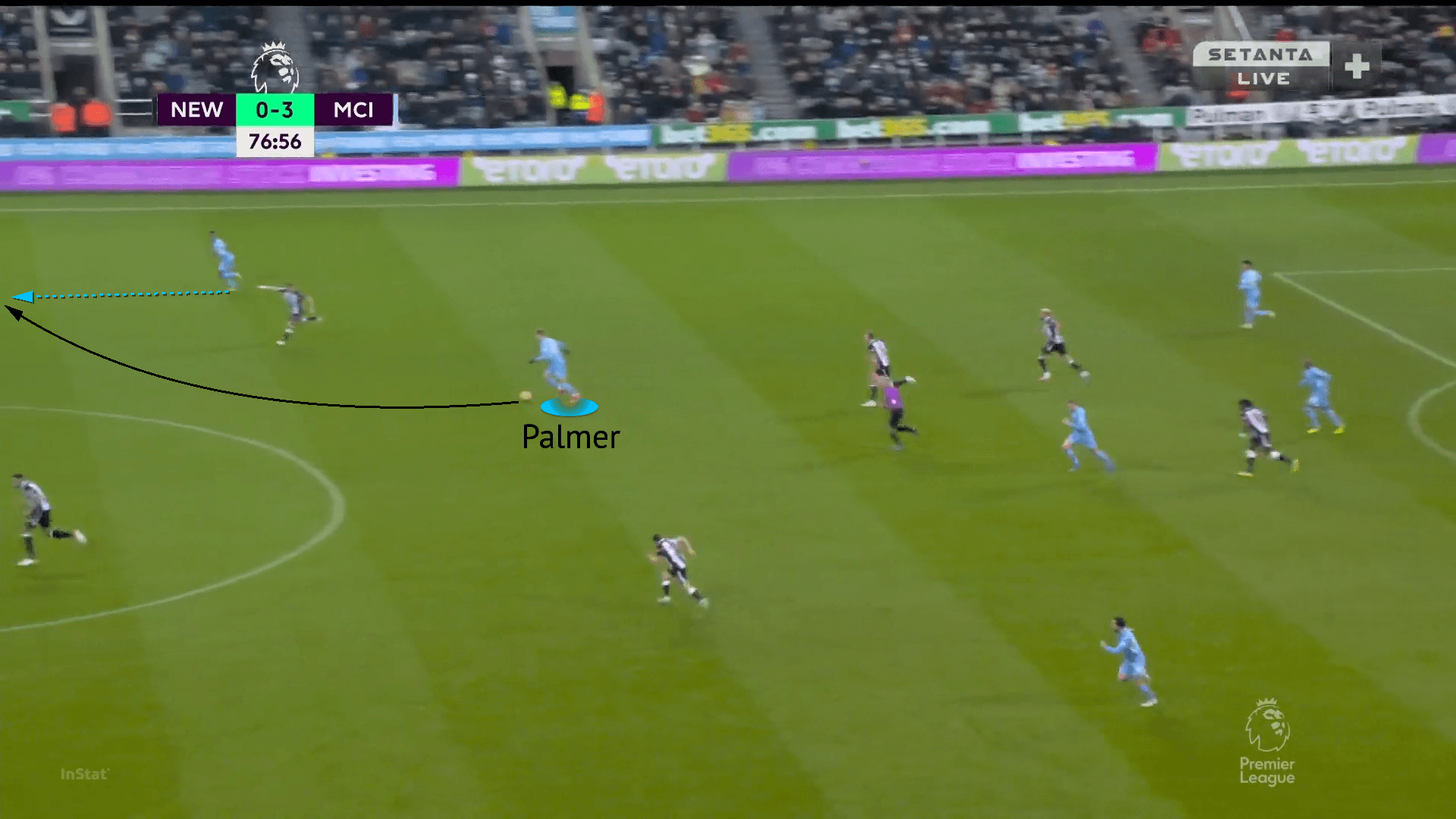
Palmer has dropped off the Newcastle back four without being followed as Fernandinho regains possession for City on the edge of the box.
Receiving on the half-turn, he quickly shifts the ball out of his feet and threads a pass between the Newcastle left-back and left-sided centre-back for Sterling to chase in behind.
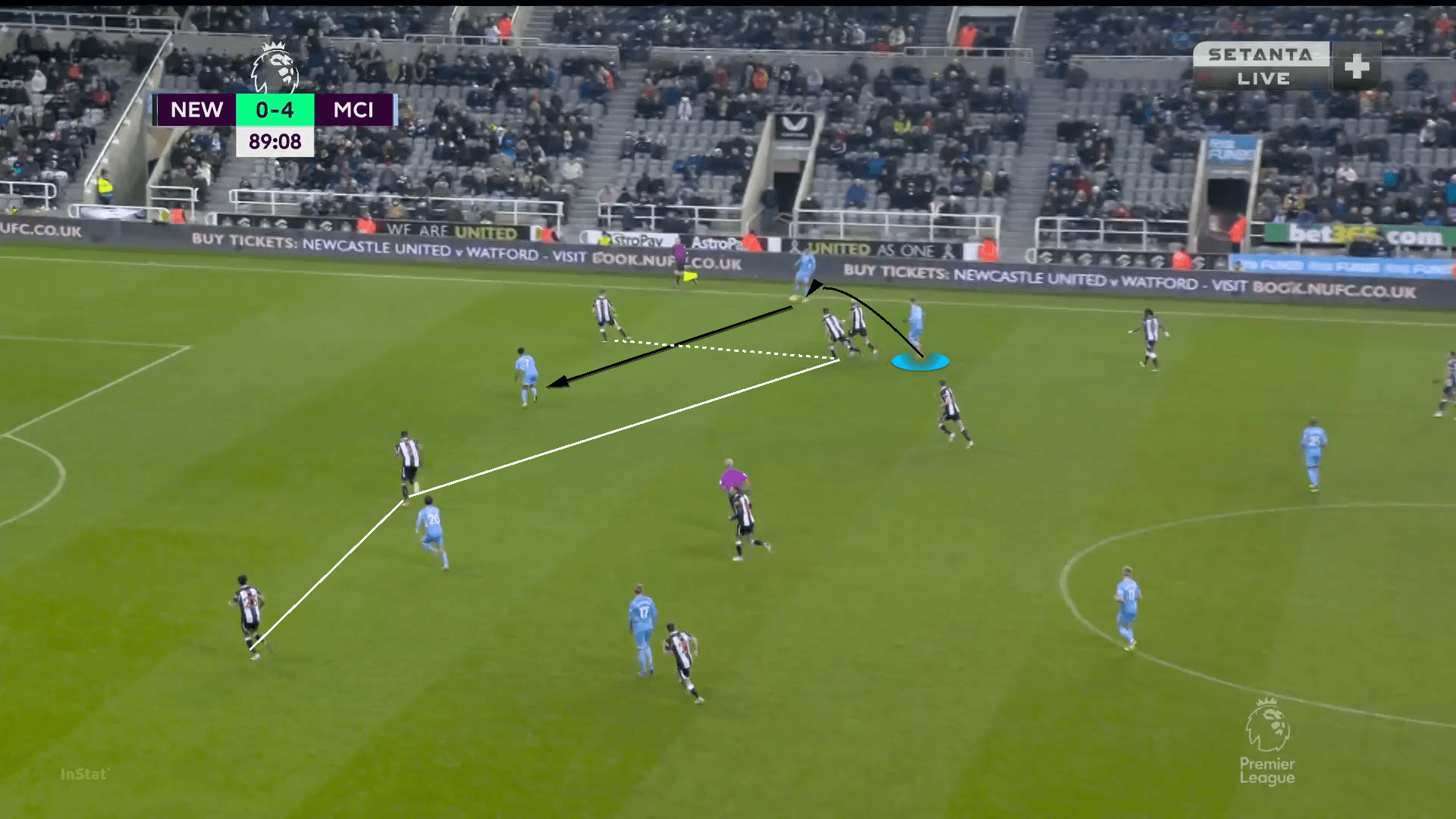
With his experience and prowess operating in midfield, particularly between the lines, Palmer is adept at dropping into such spaces from more advanced positions.
With his smart scanning and first touch alongside his passing proficiency, he is comfortable receiving ahead of the ball with opposition pressure from midfield and defence.
In the figure above, Palmer has displayed all of these qualities to perturb Newcastle’s defensive structure.
Initially positioned alongside left-sided centre-back Ciaran Clark, Palmer dropped and drifted to the right half-space to receive a pass from Stones.
Clark makes a late decision to follow Palmer, with midfielder Joelinton also drawn in by City’s rising star.
Palmer finds right-back João Cancelo, who can pass into the space previously occupied by Clark for Sterling to exploit.
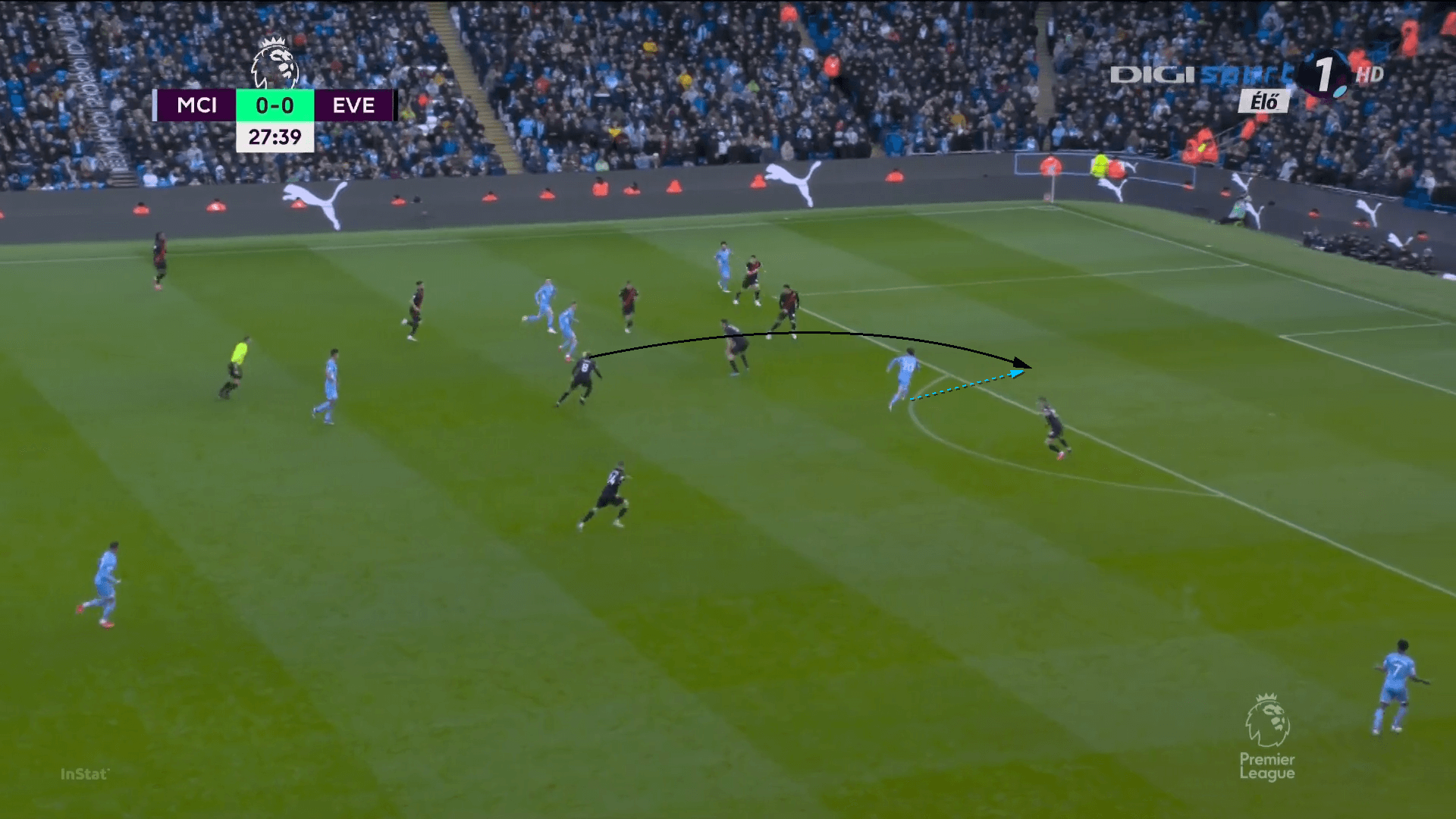
The image above is an example of Palmer’s positive and direct intention to play the killer pass whilst being deployed as a centre forward.
His tendency to drop between the lines creates spaces for him to attempt the pass and opens previously vacated spaces for teammates to penetrate.
In the example against Everton, Bernardo Silva runs behind the opponent because of Palmer’s movement.
To receive the pass from Gündoğan in space, Palmer creates separation with a double movement, initially looking to burst behind the defence before coming to a stop and dropping away.
He receives with his back to the goal, but his movement has created space for him to rotate his body around the ball without shifting the ball.
Palmer then slips a pass perfectly between the centre-back pairing of Michael Keane and Ben Godfrey at the optimal time for Bernardo Silva’s penetrative run.
Like his movements as a right winger and right-sided central midfielder, Palmer can make a variety of runs as a centre-forward that can influence opposition defences in different ways.
We’ve discussed his tendency as a centre-forward to drop into the midfield or between the lines to receive and either dribble at the defence or play a penetrative pass, but he is also capable of stretching play.
Although he doesn’t quite have the blistering pace of Haaland, these movements in behind provide a different route of progression for City and can disrupt opposition defensive structures just as much as the striker dropping off.
The image below is an example of this, with Palmer making a run between the Everton centre-backs to latch onto a pass from left-winger Phil Foden.
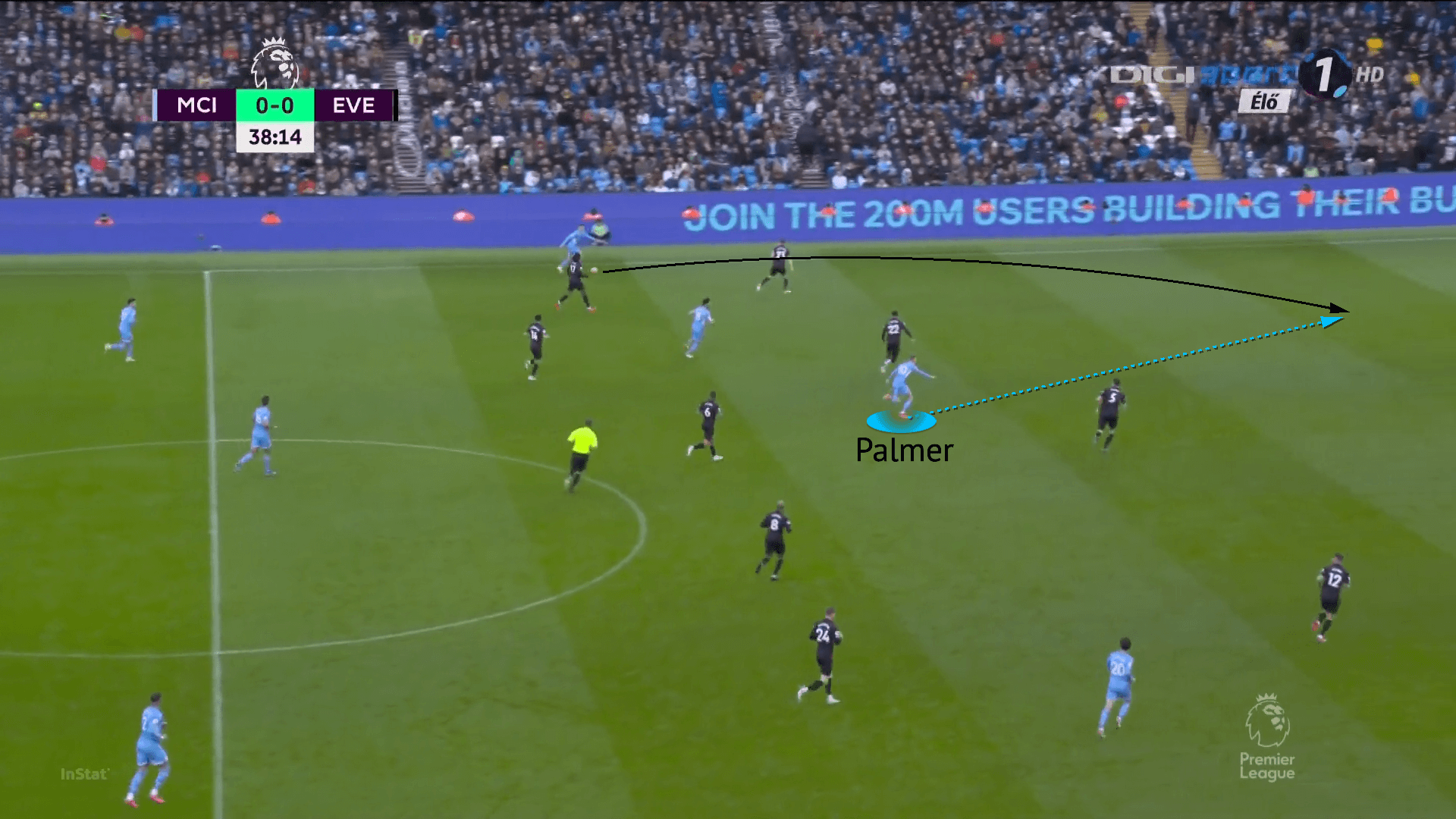
Despite Manchester City’s goals last season being spread across the team, with 18 players giving a goal-scoring contribution, one of the most significant facets of centre-forward play is scoring goals.
This quality is especially prominent in summer arrivals Haaland and Álvarez.
Haaland is coming off a 29-goal season with Borussia Dortmund at a phenomenal rate of 1.09 goals per 90 minutes.
Meanwhile, Álvarez has started 2022 with 17 goals at a rate of 0.77 goals per 90 for Argentinian giants River Plate.
Although Palmer’s 2021/22 season was disrupted, the youngster scored 17 goals across all competitions and levels at a rate of 1.06 goals per 90 minutes.
However, this remarkable goal-scoring rate is skewed by his total minutes across differing levels, especially for an attacker who was clearly levels above his opposition in the PL2.
This includes a hat-trick against Leicester City under-23s just hours after appearing in the Premier League against Burnley.
His goalscoring record does show his clinical eye for goal though.
Operating as a centre forward, Palmer has more opportunities to be positioned in central areas and inside the box.
Although his most effective shooting angles are when coming inside off the right wing, he has displayed successful techniques from different shooting positions.
Inside the box, he is capable of converting the cut-back crosses along the six-yard box or more towards the penalty box.
He has shown the anticipation to move across the face of a defender or drift round the back on their blindside.
However, the shooting angles in central areas are naturally more congested than Palmer’s typical positions off the right wing.
As a result, he must be able to quickly release shots on goal with accuracy despite having the ball manipulated to beat a man or shift the shooting angle.
The image below shows Palmer dropping away from the defence to the edge of the D.
He demonstrates his willingness to receive possession and take responsibility, commanding the ball from Rodri.
He controls the ball with his right foot and swivels to shoot with his left foot as Everton midfielders Allan and Andros Townsend close in.
The shot is struck with power towards the bottom right corner, forcing a good save from England No.1 Jordan Pickford.
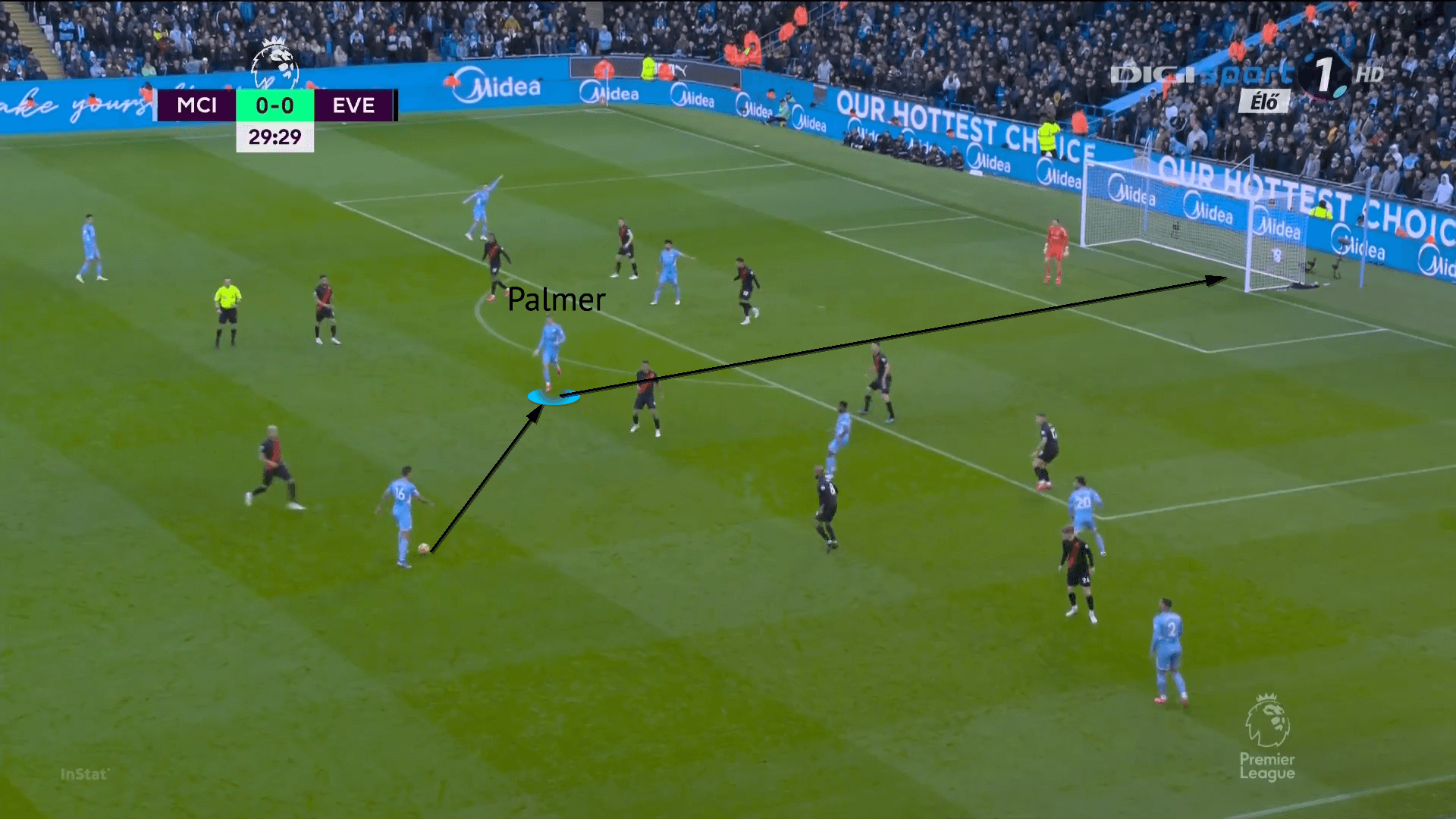
Conclusion
After an action-packed season with dramatic endings to their triumphant Premier League and traumatic Champions League campaigns, Manchester City are freshening up their squad ahead of the 2022/23 season.
With the departures of established first-team performers Fernandinho, Raheem Sterling, Gabriel Jesus, and Oleksandr Zinchenko, along with academy talents leaving the club, it seems that City is thinning out a squad that was already relatively thin before the transfer window even opened.
City have added quality depth to Guardiola’s tight-knit squad with the arrivals of ball-playing goalkeeper Stefan Ortega, malleable midfielder Kalvin Phillips and lethal attackers Erling Haaland and Julián Álvarez.
Guardiola’s squad is filled with versatile options and will be stretched to its full capacity with the demands of City’s trophy hunting and World Cup congestion.
As a result, this could be a breakout season for academy graduate and England U21 international Cole Palmer.
In this analysis, we have examined Palmer’s suitability for the right winger, right-sided central midfielder, and centre-forward roles at Manchester City as his minutes look to increase next season.
His standout attributes—mesmerising ball manipulation, elegant agility and acceleration, proficient passing, and formidable finishing—make him adaptable to any attacking role.
Despite his previous centre-forward experience, it is unlikely that Palmer’s tactics play this role with the arrivals of Haaland and Álvarez, alongside pre-existing competition such as Jack Grealish, Phil Foden and Kevin De Bruyne.
Palmer has performed the central midfielder role well at youth level, but the quality and quantity of players in the City squad capable of executing the required responsibilities also mean he might struggle for minutes here.
Although he has the quality to flourish in both of these roles, the right winger role is really where he could thrive.
With such striking similarity to Riyad Mahrez and experience operating as the right width-holder for England under-21s, his attributes and understanding of the role assist this argument.
His ideal shooting angles to flex his clinical finishing appear when cutting inside off the right wing.
He has displayed the essential attributes necessary for successful performances as City’s right winger.
He understands the variety of Guardiola’s attacking strategies in wide areas and plays in the final third while still providing a different profile and skill set.
Whichever role he occupies, if given adequate minutes, next season will be the breakout year for Cole Palmer.
Expect to see City’s local lad score his first Premier League goal, alongside adding more to his tally in all competitions with enthralling performances before spearheading the Young Lions into the under-21 Euros next summer.

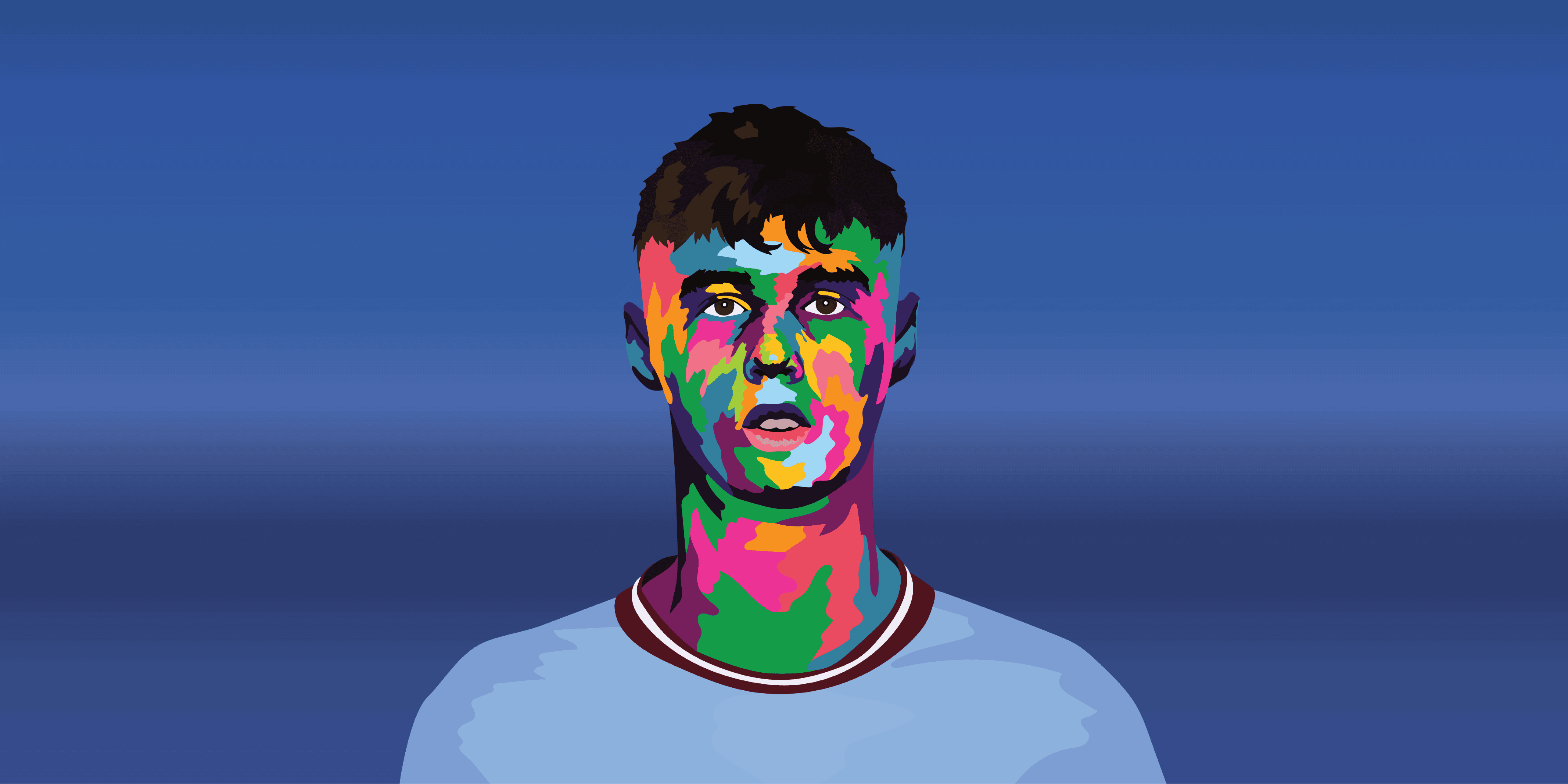




Comments